A Hammer Curl is an isolation exercise that works the arm muscles, especially the biceps, brachialis, and brachioradialis. It is named after the grip used during the exercise, which resembles holding a hammer.
It’s very similar to the biceps curl, the only difference being the neutral (hammer) hand position.
While traditional bicep curls are popular, hammer curls offer a fresh twist and a range of unique benefits. Such as:
- It effectively targets the brachialis and brachioradialis.
- It helps you to build your forearm and bicep muscles (long (outer) head of the biceps)
- They also work on grip strength.
- A neutral grip may take pressure off the wrists and elbows.
- It allows for a greater range of motion compared to traditional bicep curls.
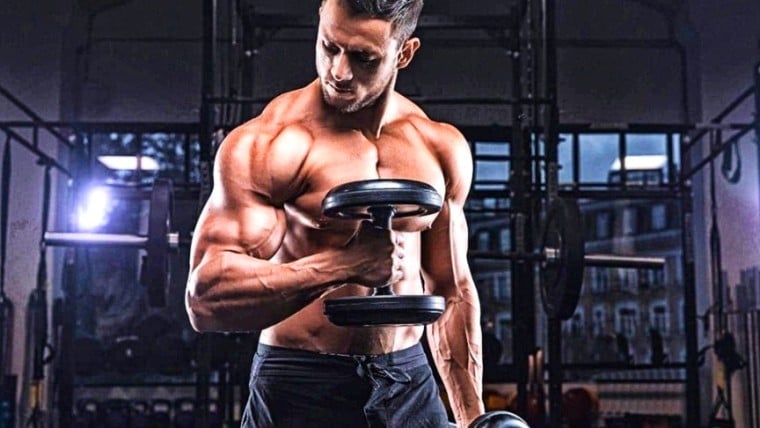
- Hammer Curl Muscles Worked
- How To Do Dumbbell Hammer Curl
- Hammer Curl Form And Techniques
- Best Variations Of Hammer Curl
- 1. Cable Hammer Curl
- 2. Cross-Body Hammer Curl
- 3. Hammer Preacher Curl
- 4. Incline Hammer Curl
- 5. Alternating Hammer Curl
- 6. Spider Hammer Curl
- 7. Seated Hammer Curl
- 8. Barbell Hammer Curl
- FAQs
- What do hammer curls workout
- Are hammer curls good and effective?
- Are hammer curls better for forearm development than regular curls?
- What is the difference between normal biceps curls and hammer curls?
- Are hammer curls suitable for individuals with wrist pain or injuries?
- Can I perform hammer curls using resistance bands?
- Conclusion
- References
Hammer Curl Muscles Worked
- The hammer curl primarily targets the upper and lower arm muscles — most notably the brachialis and brachioradialis.
- The hammer curl involves several synergist muscles, including the biceps and forearm.
- A handful of other muscles worked as stabilizer muscles, including your Obliques, and Rectus abdominis.
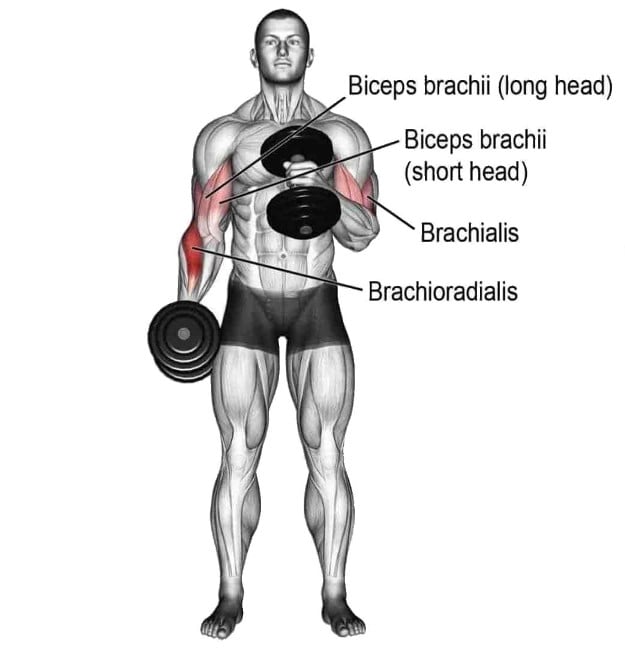
How To Do Dumbbell Hammer Curl
- Stand upright with a dumbbell in each hand, with a neutral grip (thumbs around the handles with your palms facing your body).
- Position the dumbbells alongside your thighs with your elbows fully extended.
- Keep your elbows close to your torso and your upper arms stationary.
- Exhale and slowly curl the dumbbells upward by contracting your biceps until the dumbbell nears the front of your shoulder.
- Hold the contracted position for a moment and squeeze your biceps and forearms.
- Inhale and slowly lower the dumbbells back towards your starting position until the elbow(s) are fully extended.
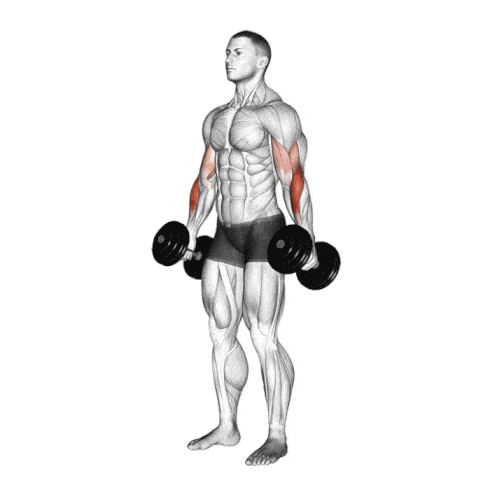
Hammer Curl Form And Techniques
- You should perform the curl while keeping your torso erect (without arching your low back) or without moving your elbows forward.
- Maintain a neutral wrist position (wrist straight without any bend, with your palms facing your body).
- Remember to keep the elbows in and your upper arms stationary. Only the forearms should move.
- Please choose a weight that allows you to perform the exercise with a full range of motion. Excessive weight can lead to poor form.
- Avoid swinging the weight or using momentum to try to lift the weight.
- Your head and neck should be aligned with your spine.
- Do the exercise slowly, so your momentum doesn’t contribute to the movement. It is also important to establish a solid mind-muscle connection.
- Exhale as you pull your arms back, and inhale as you come back. Keep your breathing steady.
- Allow your muscles to recover and grow. Aim for at least 36–48 hours of recovery time for each muscle group before training them again.
- Use supersets or drop sets to increase the intensity of the exercise. For a superset, you can do a bicep curl followed by a hammer curl.
- Incorporate different variations of hammer curls to challenge your muscles in new ways.
- Select the set, reps, and frequency as per your fitness level. As you become more comfortable with the form, feel free to change your set and rep ranges to challenge yourself.
| Level | Sets per Workout | Reps per Set | Frequency (Times per Week) |
|---|---|---|---|
| Beginner | 2-3 | 8-10 | 1-2 |
| Intermediate | 3-4 | 8-12 | 2-3 |
| Advanced | 4-5 | 8-15 | 2-3 (with rest days) |
Best Variations Of Hammer Curl
Do hammer curls in different ways to keep your workout routine fresh and challenge your muscles. Here are a few popular hammer curl variations you can try:
1. Cable Hammer Curl
The cable hammer curl is a widely practiced exercise that targets the biceps and forearms.
Unlike conventional dumbbell hammer curls, cable hammer curls provide constant tension on the muscles throughout the entire range of motion.
Cable machines are easy to use and can be adjusted to fit different fitness levels. They can also be used in progressive overload.

How To Do
- Attach a rope attachment to a low pulley and stand facing the machine.
- Grasp the rope with a neutral (palms-in) grip. Keep your back straight, chest up, and shoulders relaxed.
- Put your elbows by your side and keep them there during the entire movement.
- Pull your arms until your biceps touch your forearms. Hold for a second.
- Slowly, start to bring the weight back to the original position.
- Maintain a controlled tempo and do 8–10 reps
Know More: Bicep Cable Workout To Build Mass And Strength
2. Cross-Body Hammer Curl
The cross-body hammer curl also targets the brachialis, long-head bicep, and forearm muscles. Rather than lifting the weights directly in front of the body, you lift them across the torso.
By lifting the weight across your body, you immediately place the long head of your biceps under more tension, naturally making it an excellent outer bicep curl if your long head is lagging.
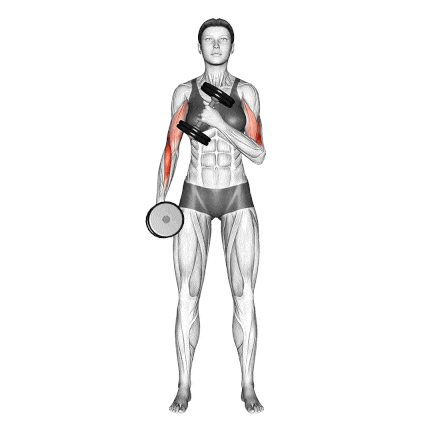
How To Do
- Stand with your feet shoulder-width apart and a slight bend in your knees.
- Hold dumbbells in your hands with your palms facing towards your body.
- Keeping your elbows close to your body, slowly curl the left dumbbell upward, across your body, and toward your left shoulder.
- Pause at the top of the lift for a second, squeeze your biceps, and then lower the weights under control.
- Repeat this with your right arm and continuously alternate your arms.
3. Hammer Preacher Curl
The Hammer preacher curl is a variation of the preacher curl exercise that specifically targets the brachioradialis and brachialis muscles.
It is performed on a preacher curl bench, which provides support and allows you to hold dumbbells with a neutral grip. This helps isolate the biceps and forearm muscles.
The preacher curl bench is stable, so you can focus on the targeted muscles without worrying about swinging or using momentum. It is my favorite way of doing a hammer curl.
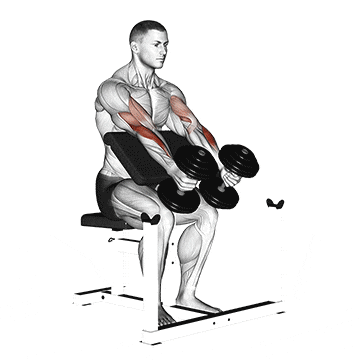
How To Do
- Set up on a preacher curl bench, adjusting the seat height so that your armpits rest comfortably on the angled pad.
- Grab a dumbbell in each hand with a neutral grip.
- Rest your arm against the bench with your arm extended fully down.
- Slowly curl the dumbbells up towards your shoulder.
- Hold for a count and squeeze your biceps and forearm.
- Inhale and slowly lower the weight back down.
4. Incline Hammer Curl
Hammer curls involve sitting on an incline bench, typically set at a 45-degree angle, while performing hammer curls.
It’s important to know that the bench’s angle helps your arms stay in place and works your muscles better than regular hammer curls.
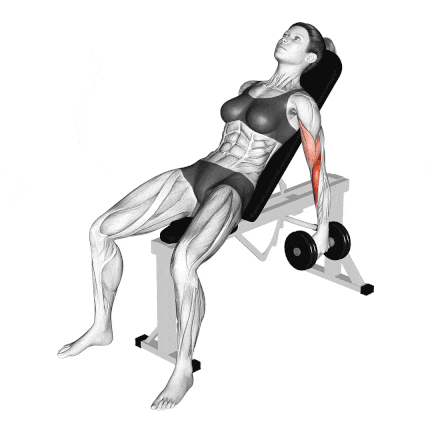
How To Do
- An incline bench should be set at a comfortable angle, usually around 45 degrees.
- Sit on the bench with a dumbbell in each hand and palms facing each other.
- Ensure your back is pressed against the bench and your feet on the floor.
- Exhale and slowly curl the dumbbells upward while keeping your upper arms still.
- Continue curling until your dumbbells are close to your shoulders.
- Inhale and slowly lower the dumbbells back down to the starting position.
5. Alternating Hammer Curl
As a certified trainer, I have observed that many clients prefer alternating hammer curls over bilateral movements.
In an alternating hammer curl, you move one arm at a time. Alternating between arms increases focus and concentration, strengthens the mind-muscle connection, and helps muscles work better.
You will also likely notice that you can achieve a slightly greater range of motion with each arm than doing both simultaneously.
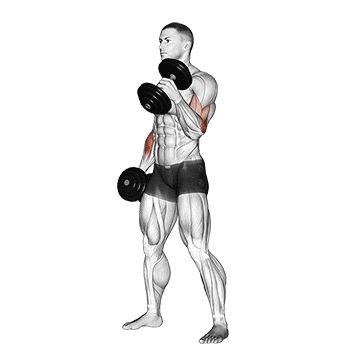
How To Do
- Stand upright with a dumbbell in each hand, arms fully extended by your sides, and palms facing each other.
- Keep your elbows close to your torso and your upper arms stationary.
- Start by curling one arm up towards your shoulder while keeping the other arm extended.
- Exhale and slowly lower the dumbbell back down to the starting position.
- Repeat the movement with the opposite arm while keeping the first arm resting.
- Continue alternating between arms for the desired number of reps.
6. Spider Hammer Curl
The dumbbell spider hammer curl may be the right choice if you like hammer curls.
We’ve spoken about a few different spider curl variations that either focus on the biceps or isolate the brachialis and brachioradialis.
However, the neutral grip variation forces all three muscles to work simultaneously, so this exercise can provide a little extra boost.
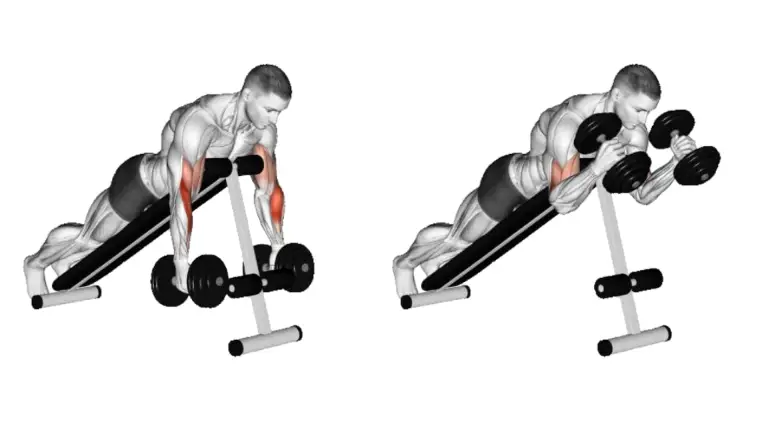
7. Seated Hammer Curl
The seated position provides a stable base, which allows you to isolate the biceps, brachialis, and forearms more effectively without relying on momentum or excessive body movement.
Seated hammer curls can help people with lower back problems. They reduce the stress on the lower back that might happen when doing standing exercises.
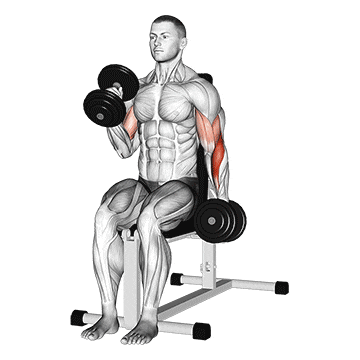
8. Barbell Hammer Curl
Barbell allows you to lift heavier weights than dumbbells, leading to greater strength and muscle development in the biceps, brachialis, and forearms.
I have also experienced the benefits of this exercise in my bicep training regimen, noticing improved grip strength and arm size.
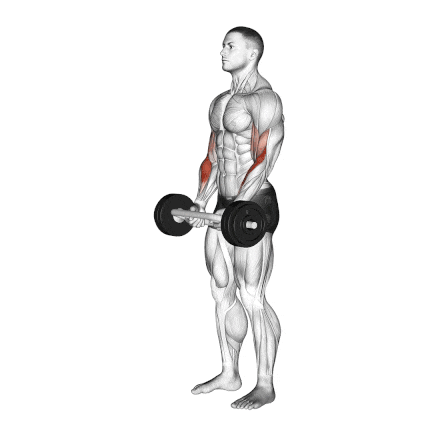
How To Do
- Stand with your feet shoulder-width apart and grasp a hammer barbell with a hammer grip.
- Hold the barbell with your hands slightly wider than shoulder-width apart. Keep your elbows close to your sides.
- Exhale and slowly curl the barbell upward toward your shoulders.
- Hold the contracted position for a moment.
- Inhale and slowly lower the barbell back down to the starting position.
FAQs
What do hammer curls workout
Hammer curls work the biceps brachii, brachioradialis, and brachialis muscles. Overall, hammer curls primarily work out the brachialis and brachioradialis muscles, with secondary involvement of the biceps.
Are hammer curls good and effective?
Yes, hammer curls are one of the best and most effective exercises for building bigger arms. They target the brachialis, brachioradialis, and biceps muscles, helping to build strength and size in the arms.
Hammer curls also offer a different grip than traditional curls, which can help maintain muscle equilibrium and prevent imbalances between the forearm and upper arm muscles.
Are hammer curls better for forearm development than regular curls?
Yes, hammer curls are generally considered more effective for forearm development due to their neutral grip position, which emphasizes the forearm muscles more.
What is the difference between normal biceps curls and hammer curls?
The main difference between normal biceps and hammer curls is the grip and targeted muscles. Normal biceps curls are performed with a supinated grip and primarily work the biceps muscles.
Hammer curls are performed with a neutral grip and target the brachialis, brachioradialis, and forearm muscles, with secondary biceps involvement.
Are hammer curls suitable for individuals with wrist pain or injuries?
It depends on the nature and severity of the wrist pain or injury. Sometimes, doing hammer curls can make the condition worse.
I recommend consulting a healthcare professional or qualified trainer to determine the appropriateness of hammer curls, or to explore modified variations that minimize wrist stress.
Can I perform hammer curls using resistance bands?
Yes, hammer curls can be performed using resistance bands instead of dumbbells or barbells. Resistance bands offer different resistance levels to challenge the muscles differently throughout the movement.
Conclusion
The hammer curl is a highly effective exercise for sculpting stronger, well-defined arms. It works the biceps, brachialis, and brachioradialis muscles, makes the forearm stronger, and makes the arm look better.
Remember to exercise correctly, increase the weight slowly as you feel more comfortable, and avoid common mistakes that can slow you down.
References
- Marcolin G, Panizzolo FA, Petrone N, Moro T, Grigoletto D, Piccolo D, Paoli A. Differences in electromyographic activity of biceps brachii and brachioradialis while performing three variants of curl. PeerJ. 2018 Jul 13;6:e5165. doi: 10.7717/peerj.5165. PMID: 30013836; PMCID: PMC6047503.
- Oliveira et al. (2009) Oliveira LF, Matta TT, Alves DS, Garcia MAC, Vieira TMM. Effect of the shoulder position on the biceps brachii EMG in different dumbbell curls. Journal of Sports Science and Medicine. 2009;8(1):24–29.
- Kostek, Mark T.; Knortz, Karen Kinesiology Corner, National Strength Coaches Association Journal: December 1980 – Volume 2 – Issue 6 – p 55-55
- Krings, B. M., Shepherd, B. D., Swain, J. C., Turner, A. J., Chander, H., Waldman, H. S., … Smith, J. W. (2019). Impact of Fat Grip Attachments on Muscular Strength and Neuromuscular Activation During Resistance Exercise. Journal of Strength and Conditioning Research, 1.

Manish brings over 10 years of hands-on experience in weight lifting and fat loss to fitness coaching. He specializes in gym-based training and has a lot of knowledge about exercise, lifting technique, biomechanics, and more.
Through “Fit Life Regime,” he generously shares the insights he’s gained over a decade in the field. His goal is to equip others with the knowledge to start their own fitness journey.
